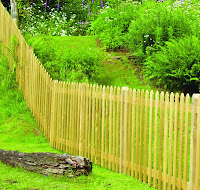Fence Panels or Traditional Kit-Form Fencing?
 |
| A Fence Panel and a Railing Topper Panel |
Fence Panels
One of the main advantages of fence panels is the speed of installation. Because they are pre-assembled, they can be fixed or slotted into posts quickly and easily, making them ideal for those who want to complete their fencing project in a short time. Additionally, they are often a cost-effective option, as they are mass-produced and widely available. Their uniform appearance creates a neat and tidy aesthetic, which is particularly appealing in urban and suburban gardens.
Another key benefit is that if a panel becomes damaged, it can be removed and replaced without disturbing the entire fence line. This makes maintenance and repairs relatively simple. There is also a wide variety of designs available, from budget-friendly lap panels to premium tongue-and-groove or decorative styles, allowing homeowners to select an option that complements their garden.
However, fence panels are not without their drawbacks. They can be less adaptable to uneven ground, as they require level installation, which can be a challenge on sloped or irregular terrain. Additionally, in high-wind areas, large solid panels can act like sails, making them more susceptible to wind damage if not properly secured. Lower-quality panels may also have a shorter lifespan, particularly if they are not pressure-treated or adequately maintained.
Traditional Kit-Form Fencing
 |
| An example of traditional palisade running up a slope |
One of the key advantages of traditional fencing is its on-site assembly. This makes installation more manageable, especially for those working alone, as there’s no need to lift and position heavy pre-made panels.
Maintenance is also easier and more cost-effective. If a few pales become damaged, they can be replaced individually, whereas a broken fence panel often requires purchasing an entirely new section.
Additionally, traditional fencing offers greater flexibility when determining fence length. Cutting rails to size and adjusting the number of pales as needed is far simpler than trimming down pre-made panels to fit the space.
Choosing between Fence Panels and Kit-Form (traditional) Fencing
Both traditional fencing and fence panels have their own benefits. Fence panels provide a quick, cost-effective solution with a uniform appearance, while traditional fencing offers durability, adaptability, and a customisable finish. The best choice depends on factors such as budget, location, and personal preference. Whichever option you choose, investing in high-quality materials, proper installation, and regular maintenance will ensure your fence remains secure and visually appealing for years to come.



